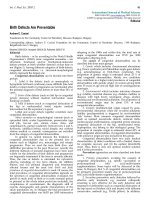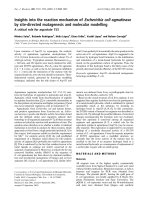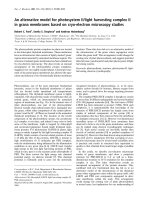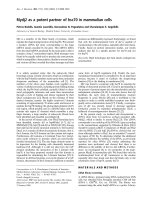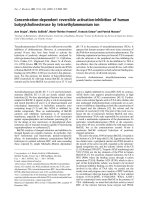Báo cáo y học: "Proteinase-3 as the major autoantigen of c-ANCA is strongly expressed in lung tissue of patients with Wegener’s granulomatosis" pptx
Bạn đang xem bản rút gọn của tài liệu. Xem và tải ngay bản đầy đủ của tài liệu tại đây (2.35 MB, 7 trang )
Research article
Proteinase-3 as the major autoantigen of c-ANCA is strongly
expressed in lung tissue of patients with Wegener’s
granulomatosis
Holger Brockmann
1
, Andreas Schwarting
1
, Jörg Kriegsmann
2
, Peter Petrow
2
, Andreas Gaumann
2
,
Klaus-Michael Müller
3
, Peter Robert Galle
1
and Werner Mayet
4
1
Department of Medicine, University of Mainz, Mainz, Germany
2
Institute of Pathology, University of Mainz, Mainz, Germany
3
Institute of Pathology, Professional Associations Hospital, Ruhr-University, Bochum, Germany
4
Center of Internal Medicine, Nordwest Hospital, Sanderbusch, Germany
Correspondence: Werner J Mayet, MD, Center of Internal Medicine, Nordwest Hospital, Sanderbusch, Germany. Tel: +49 4422 801101;
fax: +49 4422 801130; e-mail:
Introduction
Proteinase-3 (PR-3) is a 29,000 Da neutral serine pro-
teinase stored in the azurophil granules of polymorphonu-
clear leukocytes [1]. An increasing number of
physiological and pathological properties of PR-3 have
been reported. PR-3 has broad proteolytic activity and
degrades a variety of extracellular matrix proteins, includ-
ing fibronectin, type IV collagen and laminin [2,3]. PR-3 is
identical to myeloblastin, which is a growth-promoting
protein from myeloid cells [4]. Via a nonproteolytic mecha-
nism, PR-3 has potent antimicrobial activity both against
bacteria and fungi [5,6]. PR-3 was recently shown to
induce apoptosis in cultured human endothelial cells [7].
PR-3 is also identical to the target antigen (antineutrophil
cytoplasmic antibodies with a cytoplasmic staining pattern
[c-ANCA]) associated with some systemic vasculitides
such as WG and microscopic polyarteritis [8]. It is not yet
known whether antineutrophil cytoplasmic antibodies
Abstract
Proteinase-3 (PR-3) is a neutral serine proteinase present in azurophil granules of human
polymorphonuclear leukocytes and serves as the major target antigen of antineutrophil cytoplasmic
antibodies with a cytoplasmic staining pattern (c-ANCA) in Wegener’s granulomatosis (WG). The WG
disease appears as severe vasculitis in different organs (e.g. kidney, nose and lung). Little is known
about the expression and distribution of PR-3 in the lung. We found that PR-3 is expressed in normal
lung tissue and is upregulated in lung tissue of patients with WG. Interestingly, the parenchymal cells
(pneumocytes type I and II) and macrophages, and not the neutrophils, express PR-3 most strongly
and may contribute to lung damage in patients with WG via direct interaction with antineutrophil
cytoplasmic antobodies (ANCA). These findings suggest that the PR-3 expression in parenchymal
cells of lung tissue could be at least one missing link in the etiopathogenesis of pulmonary pathology in
ANCA-associated disease.
Keywords: granuloma, in situ hybridization, pneumocytes, proteinase-3, Wegener’s granulomatosis
Received: 23 April 2001
Revisions requested: 1 June 2001
Revisions received: 17 December 2001
Accepted: 4 January 2002
Published: 27 March 2002
Arthritis Res 2002, 4:220-225
This article may contain supplementary data which can only be found
online at />© 2002 Brockmann et al., licensee BioMed Central Ltd
(
Print ISSN 1465-9905; Online ISSN 1465-9913)
ANCA = antineutrophil cytoplasmic antibodies; APAAP = alkaline phosphatase–antialkaline phosphatase; c-ANCA = antineutrophil cytoplasmic
antibodies with a cytoplasmic staining pattern; PR-3 = proteinase-3; WG = Wegener’s granulomatosis; RT-PCR = reverse transcriptase-
polymerase chain reaction.
Available online />Available online />(ANCA) are directly involved in the pathogenesis of WG
or are merely an epiphenomenon [9–11].
It has previously been thought that PR-3 expression was
confined to the promyelocytic/myelocytic stage of
hematopoiesis [12]. However, other cells are also capable
of de novo synthesis of PR-3 mRNA. In vitro studies
revealed that PR-3 expression can be induced by
cytokines in human endothelial cells [13,14].
The lung is the organ most frequently involved in WG, and
in some cases it is the only organ affected [15]. Given the
potential importance of PR-3 in the pathogenesis of WG,
we sought to define the expression pattern of PR-3 in lung
tissue.
Materials and methods
Patients
Normal tissues were obtained from five patients undergo-
ing total pneumonectomy because of lung cancer. Tissue
samples were snap-frozen in OCT Tissue Tek embedding
medium (Leica Instruments, Hamburg, Germany).
We also obtained samples from five patients with WG and
a proven lung involvement from the Institute of Pathology,
University of Bochum/Clinic Bergmannsheil. All of these
patients had a c-ANCA titer of more than 1:160 (indirect
immunofluorescence on alcohol-fixed neutrophils).
Northern blot analysis
Total RNA was isolated from normal lung tissue with
RNeasy (Quiagen, Hilden, Germany) and used for prepa-
ration of mRNA with the mRNA isolation kit (Hoffmann-La
Roche, Grenzach-Whylen, Germany). The northern blot
was performed as described by Müller-Ladner et al. [16].
Preparation of the single-strand PR-3 RNA probe
The cDNA sequences, used as probes for the mRNA of PR-3
components, were obtained by RT-PCR of total cellular
mRNA of HL-60 cells, a myelomonocytic cell line [5]. The fol-
lowing primers were used in this study: PR-3 ‘sense’, 5′-ATC-
GTGGGCGGGCACGAGGCG (at the beginning of exon 2,
corresponding to bases +82 to +101 of the cDNA); and
PR-3 ‘antisense’, 5′-GCGGCCAGGGAACGAAAGTGCA
(at the end of exon 4, corresponding to bases +553 to
+582). The expected size of the fragment was 500 base
pairs. The cDNA fragment was extracted and purified from a
preparative gel using the Wizard PCR preps DNA purification
system (Promega A 7170, CA, USA) and subcloned into the
polylinker site of bluescript SK+ (Stratagene, CA, USA).
Antisense and sense RNA probes were transcribed by T3
and T7 RNA polymerase using a commercially available
RNA transcription kit, according to the protocol recom-
mended by the manufacturer (Stratagene). Probes were
labeled with Digoxigenin-UTP (Hoffmann-La Roche).
In situ
hybridization
Frozen sections (4–6 µm) were cut, air-dried and fixed
immediately in acetone for 15 min. Formaldehyde-fixed
sections were deparaffinized according to standard proce-
dure. The sections were prepared according to the
method of Müller-Ladner et al. [16].
Immunological detection
The slides were washed in Tris–NaCl (pH 7.6) and incu-
bated in Tris–NaCl containing 2% normal goat serum (to
block nonspecific binding) for 30 min at room tempera-
ture, followed by incubation with antidigoxigenin–alkaline
phosphatase–antibody complex (Hoffmann-La Roche) in
Tris–NaCl (pH 7.6) for 1 hour at room temperature. Then
45 µl NBT (Boehringer Mannheim, Germany), 35 µl BCIP
(Hoffmann-La Roche) and 24 µl Levamisole (Hoffmann-La
Roche) were solved in 10 ml polyvinyl alcohol in a dark-
ened chamber. Two hundred milliliters were applied to
each section and incubated for between 12 and
24 hours. The sections were then mounted with aqueous
gel (Faramount; Dako, Glostrup, Denmark) or stored at
4°C in Tris (pH 7.6) for double-labeling by the alkaline
phosphatase–anti-alkaline phosphatase (APAAP) method
(see later).
Immunohistochemical double-labeling (APAAP method)
Double-labeling was performed using the APAAP method,
with monoclonal antibody against CD68 (macrophages
mouse IgG, 1:50; Dako), CD15 (granulocytes IgM, 1:50;
Dianova, Hamburg, Germany), CD20 (B lymphocytes,
1:50; Dako), CD3 (T lymphocytes, 1:50; Dako), and
Cytokeratin 8 and 19 (mouse IgG
1
, 1:25 and 1:200; Hoff-
mann-La Roche). Paraffin sections were prepared as
described by Müller-Ladner et al. [16].
Double-labeling with biotin/fluorescence-coupled lectins
PR-3 hybridized sections were overlaid with fluorescein
isothiocyanate/biotin-coupled Bauhinia purpurea and
Maclura pomifera lectin diluted 1:200 and 1:500,
respectively, for 30 min. Subsequently, slides were
sequentially analyzed with light and fluorescent
microscopy. The lectin of B. purpurea binds specifically
to pneumocytes type I, whereas the lectin of M. pomifera
binds to pneumocytes type II.
Microscopic evaluation and semiquantitative analysis
of PR-3 mRNA expression
Sections were examined and photographed with a Leica
Microscope DMRX (Leitz, Wetzlar, Germany). For quanti-
tative analysis, a representative area between 1000 and
10,000 cells depending on the specimen was defined. In
the representative areas, positive cells for PR-3 mRNA
were scored in a semiquantitative fashion as follows: –, no
positive cells; (+), <5% of cells positive; +, between 5%
and 30% of cells positive; ++, between 30 and 60% of
cells positive; +++, >60% of cells positive.
Arthritis Research Vol 4 No 3 Brockmann et al.
Results
Northern blot analysis
We searched for PR-3 mRNA expression in different
human tissues. We confirmed the presence of a strong
single 1.3 kb band (the expected size for PR-3 mRNA),
especially in lung tissue. We found just a very weak signal
in the heart and brain, and could not detect a band in liver
tissue (Supplementary Fig. 1).
In situ
hybridization for PR-3 mRNA in normal lung
Nearly all PR-3 mRNA-positive cells were located at the
alveolus covering cell layer (Fig. 1). PR-3 mRNA expres-
sion was mostly focused in areas showing macrophages
in alveoles. The results obtained by in situ hybridization
were reproducible in all biopsies. No hybridization signals
were detected in the control experiments using a sense
RNA probe (Supplementary Fig. 2).
Characterization of PR-3 mRNA-positive cells in normal
lung
With regard to the histomorphological appearance and
localization of the PR-3-positive cells, these cells
appeared to be mostly pneumocytes. Double-staining
with fluorescent lectins of M. pomifera and B. purpurea
lectins confirmed the PR-3 mRNA expression in pneumo-
cytes type I and II (Figs 2 and 3). Double-staining with
markers for granulocytes and macrophages revealed that
the majority of the PR-3 mRNA-positive cells were differ-
ent from these cells (Fig. 1). Only a few CD68-positive
and CD15-positive cells also showed a signal for PR-3
mRNA (Fig. 4).
In situ
hybridization for PR-3 mRNA in lung tissue of
WG patients
We studied lung tissue from five patients with histologi-
cally and clinically proven WG and lung involvement. We
found a very pronounced PR-3 expression throughout the
whole slide in all cases. In comparison with the normal
lung tissue where the PR-3 expression was confined to
just a few spots, the expression in WG tissue was nearly
ubiquitous (Fig. 5). We also observed a strong positive
PR-3 mRNA signal at the sites of granulomas, inflamma-
tory infiltration and vasculitis (Supplementary Fig. 3).
To obtain a semiquantitative estimation of PR-3 expression
difference, we counted all cells positive for PR-3 mRNA.
We found an approximately double to threefold PR-3
expression in WG tissues compared with normal lung
tissue (Table 1).
Characterization of PR-3 mRNA-positive cells in WG tissue
We found PR-3 mRNA expression mostly in pneumocytes
type I and II. In comparison with normal tissue, however,
there was a higher number of infiltrating, PR-3 expressing
cells, different from pneumocytes.
Double-staining with different markers (CD20, CD3,
CD15, and CD68) for inflammatory cells such as B cells,
T cells, granulocytes and macrophages helped in the char-
acterization of these cells. We detected B cells in some
secondary lymphoid follicles and a few scattered in the
tissue. T cells were virtually absent in the tissue. The B
cells and T cells did not express PR-3 mRNA at all. Apart
Figure 1
Proteinase-3 (PR-3) mRNA is expressed in alveolar epithelial cells in a
human lung specimen (arrows). The expression of PR-3 mRNA was
detected by nonradioactive in situ hybridization. Double-labeling with
CD15 revealed some infiltrating neutrophils (red cells), different from
the PR-3 mRNA expressing cells (magnification, 40 × 2.5).
Figure 2
Proteinase-3 (PR-3) mRNA is expressed in pneumocytes type I in
human lung tissue (arrows). The expression of PR-3 mRNA was
detected by nonradioactive in situ hybridization, and the pneumocytes
type I were detected by double-labeling with biotin-labeled lectins of
Bauhinia purpurea (magnification, 60 × 2.5).
Available online />from some PR-3 mRNA expressing granulocytes, most of
these infiltrating PR-3 mRNA expressing cells were
macrophages (Supplementary Fig. 4). We found this kind
of distribution of PR-3 mRNA expressing cells at sites of
inflammatory infiltration, granulomas and vasculitis. At the
site of vasculitis, we detected PR-3 mRNA-positive cells
that were different from inflammatory cells. From their
histopathological appearance, these cells could be
endothelial cells (Supplementary Fig. 4).
Expression of the PR-3 protein in normal lung and WG
tissue
To visualize the PR-3 protein expression, we performed
immunohistological experiments with a monoclonal anti-
body (WGM2) from mice, specific for PR-3.
We found the PR-3 protein in only few cells in normal lung
tissue. According to the strong PR-3 mRNA expression,
we also found an increased PR-3 protein expression in
WG tissue (Fig. 6 and Supplementary Fig. 5).
Figure 4
Proteinase-3 (PR-3) mRNA is expressed in macrophages (arrows).
Some cells express the PR-3 mRNA detected by nonradioactive in situ
hybridization and double-labeling with CD68, a marker for macrophages
(magnification, 40 × 2.5).
Figure 5
Proteinase-3 (PR-3) mRNA expression in a Wegener’s granulomatosis
lung specimen. The PR-3 mRNA was found strongly expressed and
dispersed all over the lung tissue. The expression of PR-3 mRNA was
detected by nonradioactive in situ hybridization (magnification, 20 × 2.5).
Figure 3
Proteinase-3 (PR-3) mRNA is expressed in pneumocytes type II in normal
lung tissue (arrows). The expression of PR-3 mRNA was detected by
nonradioactive in situ hybridization, and the pneumocytes type II were
characterized by double-labeling with fluorescent lectins of Maclura
pomifera (magnification, 60 × 2.5).
Table 1
Semiquantitative analysis of proteinase-3 mRNA expression in
normal lung and Wegener’s granulomatosis (WG) lung
specimens
Specimen Normal lung WG lung
1+++
2 (+) +++
3 (+) ++
4+++
5 + +++
A representative area between 1,000 and 10,000 cells depending on
the specimen was defined. In the representative areas, positive cells
for PR-3 mRNA were scored in a semiquantitative fashion: –, no
positive cells; (+), < 5% of cells positive; +, between 5% and 30% of
cells positive; ++, between 30 and 60% of cells positive; +++, > 60%
of cells positive.
Discussion
The diagnosis and classification of WG and related vas-
culitides were advanced considerably by characterization
of serum antibodies that react with PR-3 (c-ANCA) [17]. It
is not yet known whether ANCA are directly involved in the
pathogenesis of WG or are merely an epiphenomenon
[10]. One of the unresolved issues is the inability to
explain the nonrandom, selected organ injury that defines
the WG vasculitis and the concurrent, seemingly random,
nature of injury within ‘targeted’ organs [18]. Little is
known about the expression and distribution of PR-3 in the
normal lung and in the lung tissue of patients with WG.
To contribute to this little-known issue, we examined the
PR-3 expression in normal lung and lung tissue of WG
patients, as the lung is the most frequent organ involved in
WG [15]. In normal lung tissue, mainly pneumocytes type I
and type II and just a few granulocytes and macrophages
express PR-3. We could detect the PR-3 mRNA expres-
sion in pneumocytes especially at sites with an increased
number of infiltrating macrophages. Speculatively, these
cells could be responsible for initiating PR-3 mRNA
expression; probably through changing the microenviron-
mental cytokine levels. Cytokines like interleukin-1 and
tumor necrosis factor-α, secreted from macrophages, can
induce PR-3 mRNA in nonhematopoietic cells [19].
The different expression of PR-3 in pneumocytes could
also be due to variations of transcription factors. One pos-
sible candidate gene could be PU.1, which regulates the
PR-3 transcription in B cells and macrophages. The
expression in other nonhematopoietic cells, in particular
pneumocytes, has not been extensively investigated
[20,21]. Although expressed in a very small amount in
normal lung tissue, a question concerning the function of
PR-3 in normal lung arose, since the occurrence of a prote-
olytic enzyme like PR-3 should not be favorable in this
tissue [22]. It is tempting to speculate that PR-3 could also
play a role in microbiologic defense, since the enzyme also
has an antimicrobial function [6]. Further studies are clearly
needed to elucidate the function of PR-3 in pneumocytes.
After we had proven that PR-3 mRNA is expressed in
normal lung tissue, we questioned whether the expression
pattern is different in the lung tissue of WG patients. The
examined specimens of patients with WG showed strong
PR-3 mRNA expression, with a double to threefold PR-3
mRNA increase compared with normal lung tissue. Similar
to our findings in normal lung tissue, we could demonstrate
in lung tissue of WG patients that PR-3 is mostly
expressed in pneumocytes type I and type II. PR-3 expres-
sion was pronounced at sites of inflammatory infiltration,
vasculitis and granulomas. In comparison with normal lung
tissue, however, there was a higher number of infiltrating
PR-3 expressing cells, which were not pneumocytes.
Apart from some PR-3 expressing granulocytes, most of
the infiltrating PR-3 expressing cells were macrophages.
One explanation for the occurrence of PR-3-positive
macrophages in inflammatory tissue is the invasion of circu-
lating monocytes to inflammatory sites. Just et al. showed
an upregulation of PR-3 mRNA expression especially in cir-
culating monocytes, but not in neutrophils, in patients with
cystic fibrosis [23]. We found PR-3 mRNA expression in
and around vascular structures and vasculitic lesions,
where most of the infiltrating cells were characterized as
macrophages. However, a few cells seemed to be
endothelial cells. This is in line with our recent findings of
de novo synthesis of PR-3 in endothelial cells [24]. On the
contrary, most endothelial cells (even at multiple sites of
acute vasculitis with inflammatory cells, invading the vessel
and the surrounding tissue), were negative for PR-3 mRNA.
Recent studies on the kinetics and stability of PR-3 tran-
scripts revealed PR-3 mRNA expression is only transiently
upregulated in endothelial cells [25].
The histological features within the WG specimens varied
considerably with different inflammatory infiltrates and with
or without granulomas. The only apparent issue the WG
specimens have in common is the upregulation of PR-3
throughout the whole specimen. The upregulation of PR-3
in the lung of WG patients may therefore reflect the
selected organ injury, whereas the histological hetero-
geneity may represent a multiplicity of concurrent immune
responses to a unique disease precipitant like PR-3.
As it is most probable that pneumocytes, vascular endothe-
lial cells and renal epithelial cells are no longer only innocent
bystanders but active participants in inflammatory reactions
Arthritis Research Vol 4 No 3 Brockmann et al.
Figure 6
Proteinase-3 (PR-3) is also expressed on the protein level (brown
cells). The PR-3 protein was detected by WGM2 antibodies, specific
for PR-3 (magnification, 60 × 2.5).
of autoimmune vasculitides such as WG, it is very important
to study the expression pattern of PR-3 in other organs or
tissues that are involved in the manifestation pattern of WG
[26]. Schwarting et al. showed the in vitro expression of
PR-3 mRNA in tubular epithelial cells and glomerular epithe-
lial cells of the kidney [25]. In vivo experiments in the kidney
revealed a PR-3 expression in distal tubular epithelial cells
and in the glomerulum. The PR-3 mRNA expressed by
human glomerular epithelial cells correlates with crescent
formation in patients with WG [25].
We thus envision that the upregulation of PR-3 in
parenchymal lung tissue in patients with WG, probably
through an altered cytokine pattern, can lead to PR-3/
ANCA-mediated lung damage. Further in vitro experiments
and functional studies with pneumocytes will show
whether the interaction of anti-PR-3 antibodies with pneu-
mocytes will also activate signal transduction events or the
expression of chemokines or adhesion molecules.
In conclusion, we report for the first time that PR-3 mRNA,
the target antigen for c-ANCA, is expressed by normal
lung parenchymal cells and is upregulated in lung tissue of
WG patients. PR-3 mRNA may therefore contribute to
lung damage in WG and other ANCA-associated dis-
eases via direct interaction.
Acknowledgments
The authors wish to thank Ms Huong Becker for excellent technical
assistance and Dr E Csernok, Bad Bramstedt, for providing the mono-
clonal anti-PR-3 antibody WGM2.
References
1. Rao NV, Wehner NG, Marshall BC, Gray WR, Gray BH, Hoidal
JR: Characterization of proteinase-3 (PR-3), a neutrophil
serine proteinase. Structural and functional properties. J Biol
Chem 1991, 35:9540-9548.
2. Campanelli D, Melchior M, Fu Y, Nakata N, Shuman H, Nathan C,
Gabay JE: Cloning of cDNA for proteinase 3: a serine pro-
tease, antibiotic and autoantigen from human neutrophils.
J Exp Med 1990, 172:1709-1715.
3. Kao RC, Wehner NG, Skubitz KM, Gray BH, Hoidal JR: Pro-
teinase 3. A distinct human polyporphonuclear leukocyte pro-
teinase that produces emphysema in hamsters. J Clin Invest
1988, 82:1963-1973.
4. Bories D, Raynal MC, Solomon DH, Darzynkiewicz Z, Cayre Y:
Down-regulation of a serine protease, myeloblastin, causes
growth arrest and differentiation of promyelocytic leukemia
cells. Cell 1989, 59:959-968.
5. Campanelli D, Detmers PA, Nathan CF, Gabay JE: Azurocidin
and a homologous serine protease from neutrophils. Differ-
ential antimicrobial and proteolytical properties. J Clin Invest
1990, 85:904-915.
6. Gabay JE, Scott RW, Campanelli D: Antibiotic proteins of
human polymorphonuclear leukocytes. Proc Natl Acad Sci
USA 1989, 86:5610-5614.
7. Yang JJ, Kettritz R, Falk RJ, Jennette JC, Gaido ML: Apoptosis of
endothelial cells induced by the neutrophil serine proteases
proteinase 3 and elastase. Am J Pathol 1996, 149:1617-1626.
8. Laevitt Ry, Fauci AS, Bloch DA, Michel BA, Hunder GG, Arend
WP, Calabrese LH, Fries JF, Lie JT, Lightfoot RW, Masi AT,
McShane DJ, Mills JA, Stevens MB, Wallace SL, Zvaifler NJ: The
American College of Rheumatology 1990 criteria for the clas-
sification of Wegener´s granulomatosis. Arthritis Rheum 1990,
33:1101-1107.
9. Van der Woude FJ, Van Es LA, Daha MR: The role of the cANCA
antigen in the pathogenesis of Wegener’s granulomatosis. A
hypothesis based on both humoral and cellular mechanisms.
Neth J Med 1990, 36:169-171.
10. Kallenberg CGM, Brouwer E, Mulder AHL, Stegeman CA,
Weening JJ, Cohen Tervaert JW: ANCA — pathophysiology
revisited [review]. Clin Exp Immunol 1995, 100:1-3.
11. Falk RJ, Hogan S, Carey TS, Jennette JC: Clinical course of anti-
neutrophil cytoplasmic autoantibodies-associated glomeru-
lonephritis and systemic vasculitis. Ann Intern Med 1990, 113:
656-663.
12. Sturrock AB, Franklion KF, Rao G, Marshall BC, Rebentisch MB,
Lemons RS, Hoidal JR: Structure, chromosomal assignment,
and expression of the gene for proteinas-3. J Biol Chem 1992,
267:21193-21199.
13. Mayet WJ, Schwarting A, Orth T, Sibelius U, Hattar K, Meyer zum
Büschenfelde KH: Signal transduction pathways of membrane
expression of proteinase 3 (PR-3) in human endothelial cells.
Eur J Clin Invest 1997, 27:165-170.
14. Sibelius U, Hattar K, Schenkel A, Csernok E, Gross WL, Mayet
WJ, Grimminger F: Influence of monoclonal antibodies against
proteinase 3 on signal transduction and secondary cell reac-
tions in human endothelial cells. Sarcoidosis 1996, 13:263-
270.
15. Burns A: Pulmonary vasculitis. Thorax 1998, 53:220-227.
16. Müller-Ladner U, Kriegsmann J, Tschopp J, Gay R, Gay S:
Demonstration of granzyme a and perforin messenger RNA in
the synovium of patients with rheumatoid arthritis. Arthritis
Rheum 1995, 38:477-484.
17. Hoffman GS, Kerr GS, Laevitt RY, Hallahan CW, Lebovics RS,
Travis WD, Rottem M, Fauci AS: Wegener’s granulomatosis: an
analysis of 158 patients. Ann Intern Med 1992, 116:488-498.
18. Hoffman GS, Specks U: Antineutrophil cytoplasmatic antibod-
ies. Arthritis Rheum 1998, 41:1521-1537.
19. Schwarting A, Schlaak JF, Wandel E, Meyer zum Büschenfelde
KH, Mayet WJ: Human renal tubular epithelial cells as target
cells for antibodies to proteinase 3 (c-ANCA). Nephrol Dial
Transplant 1997, 12:916-923.
20. Srikanth S, Rado TA: PU.1 regulates the expression of the
human neutrophil elastase gene. Biochem Biophys Acta, 1998,
1398:215-223.
21. Sturrock A, Franklin KF, Hoidal JR: Human proteinase-3 expres-
sion is regulated by PU.1 in conjunction with a cytidine-rich
element. J Biol Chem 1996, 271:32392-32402.
22. Ritter JH: Anti-neutrophil cytoplasmic autoantibodies and pat-
terns of pulmonary disease. A spectrum of pathologic find-
ings. Am J Clin Pathol 1995, 104:1-2.
23. Just J, Moog-Lutz C, Houzel-Charavel A, Canteloup S, Grimfeld A,
Witko-Sarsat N, Cayre YE: Proteinase 3 mRNA expression is
induced in monocytes but not in neutrophils of patients with
cystic fibrosis. FEBS Lett 1999, 457:437-440.
24. Mayet WJ, Csernok E, Szymkowiak C, Gross WL, Meyer zum
Büschenfelde KH: Human endothelial cells express proteinase
3, the target antigen of anticytoplasmic antibodies in Wegen-
er’s granulomatosis. Blood 1993, 82:1221-1229.
25. Schwarting A, Hagen D, Odenthal M, Brockmann H, Dienes HP,
Wandel E, Rumpelt HJ, Meyer zum Büschenfelde KH, Mayet WJ:
Proteinase 3 mRNA expressed by human glomerular epithe-
lial cells correlates with crescent formation in patients with
Wegeners Granulomatosis. Kidney Int 2000, 57:2412-2422.
26. Mayet WJ, Helmreich-Becker I, Meyer zum Büschenfelde KH: The
pathophysiology of anti-neutrophil cytoplasmic antibodies
(ANCA) and their clinical relevance. Crit Rev Oncol Hematol
1996, 23:151-165.
Available online />Supplementary figures
Arthritis Research Vol 4 No 3 Brockmann et al.
Supplementary Figure 5
The proteinase-3 (PR-3) protein is expressed in pneumocytes type I in
Wegener’s granulomatosis tissue (arrows). The expression of PR-3
protein was detected by immunohistological staining with WGM2
antibodies, and the pneumocytes type I were detected by double-
labeling with fluorescent lectins of Bauhinia purpurea (magnification,
60 × 2.5).
Supplementary Figure 2
Human lung tissue (sense control; magnification, 20 × 2.5).
Supplementary Figure 3
Proteinase-3 (PR-3) mRNA expression in vasculitic structures.
Nonradioactive in situ expression of PR-3 mRNA is shown in the
infiltrating and surrounding cells of the vessel (magnification, 40 × 2.5).
Supplementary Figure 1
Northern blot containing approximately 2 µg polyA RNA per lane from
four different human tissues. Lanes 1–4 contain, in order, RNA from
human heart, brain, liver and lung tissue. RNA size marker bands are
indicated in the left margin of the blot (M).
Supplementary Figure 4
Proteinase-3 mRNA expression in macrophages and endothelial cells
in a Wegener’s granulomatosis lung specimen. The macrophages are
double-labeled with CD68 (red cells). The histomorphological
appearance of the marked cell points to an endothelial cell (arrow)
(magnification, 60 × 2.5).
